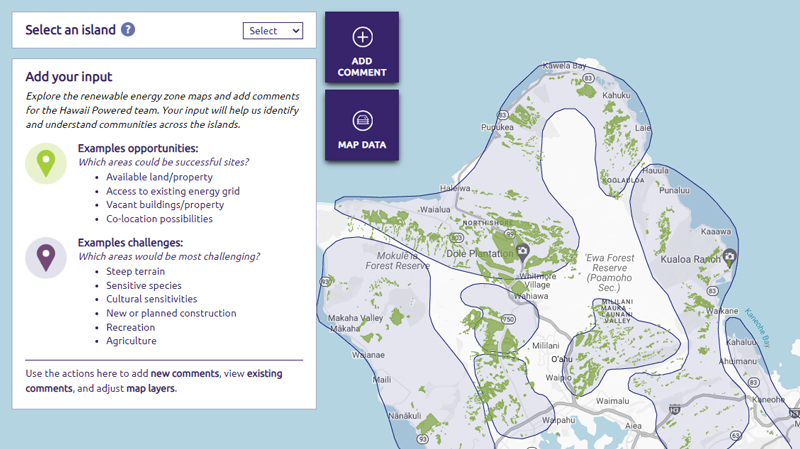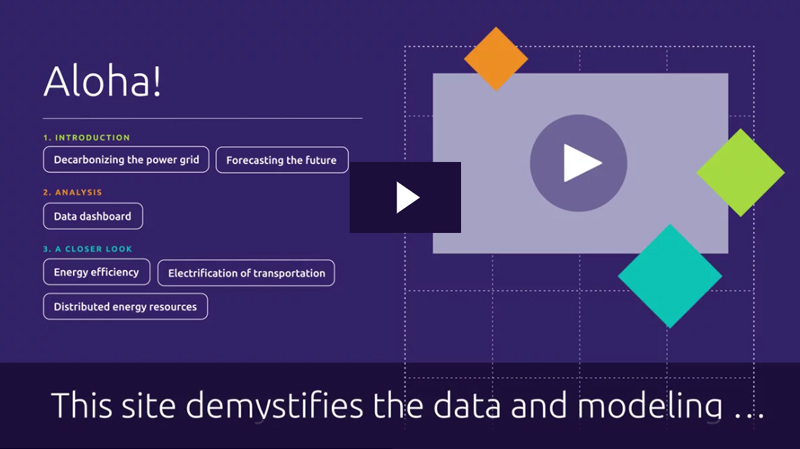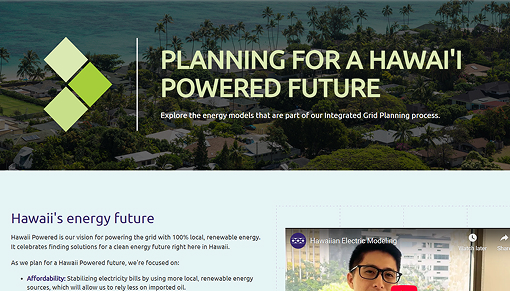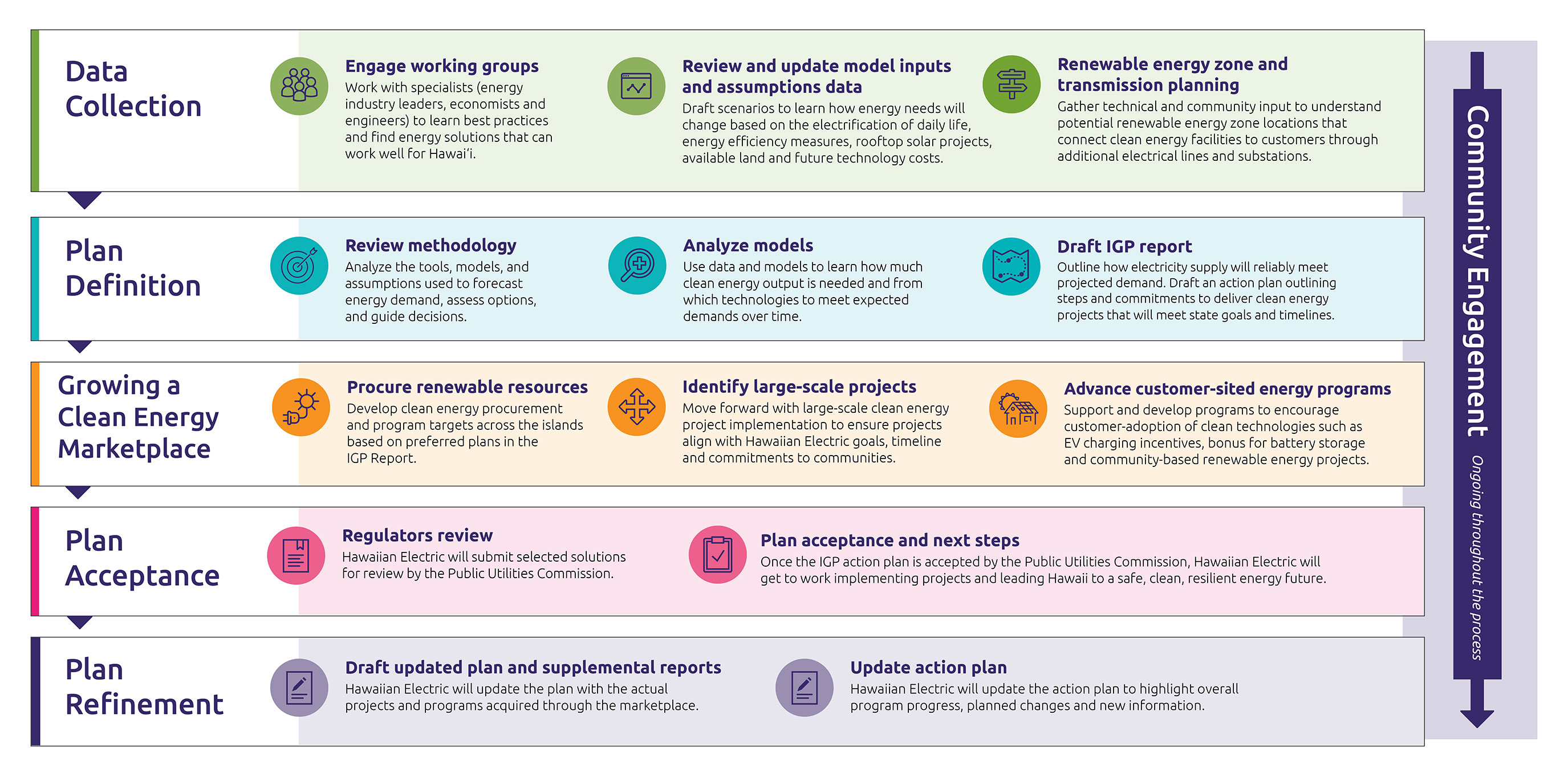Integrated Grid Plan Overview
The Integrated Grid Plan (IGP) represents the next five years of partnership with stakeholders and community members across the five islands we serve.
Together, we are creating a resilient, clean energy grid powered by resources from Hawaii, for Hawaii. The well-being of our communities, economy, and environment depends on a power system that can withstand, adapt to and recover from any challenge.
Clean Energy Today
A key strategy to reach net zero emissions is generating our energy from clean, renewable sources. As an island state, we can't rely on importing clean energy from neighboring states. Fortunately, Hawaii has an abundance of renewable resources that can power a resilient grid.
Hawaiian Electric has the privilege of serving as the largest power utility in the state, providing electricity for 95% of residents on Oahu, Maui, Molokai, Lanai and Hawaii Island.
In 2024, about 36% of Hawaiian Electric's energy generation came from renewable sources. This means we have nearly quadrupled the amount of renewable energy since 2010, when under 10% of electricity sales came from renewables. We're proud of the progress we've made, but we still have a long way to go. There are many existing and planned facilities to generate clean energy across the islands. See maps of existing and planned facilities in our 2024-2025 Sustainability Report & Maps.
A resilient clean energy grid is diverse and balanced. Relying on a single source of energy makes us more vulnerable to energy markets, unexpected events and natural changes in energy sources (for example, days when tradewinds slow down or the sun is not shining). Integrating diverse energy sources and technologies:
- Expands our energy options
- Helps us adapt to evolving energy needs
- Makes it easier to bounce back from unexpected events like earthquakes or storms
- Provides more reliable power and predictable pricing for customers
Where does Hawaiian Electric's renewable energy come from?
Our renewable energy comes from many local sources with wide-ranging technologies. Click below to learn about the types of clean energy we use today.
- Customer DER
- Wind
- Solar
- Biomass
- Geothermal
- Biofuel
- Hydro-energy
Customer DER
Customer distributed energy resources, or DER, refers to smaller generators located throughout the energy grid, such as private rooftop solar or battery storage systems mounted on customers' homes and businesses. These systems and tools contribute to a resilient clean energy grid, which is based on diverse renewables and different scales of energy generation. Hawaii leads the country in customer-sited DER and has several programs available to customers who want to offset their energy bill by investing in clean energy generation.
IGP Resources
Renewable Energy Zones (REZ) Interactive Map
Explore an interactive map that combines energy potential data and public input to identify potential project locations. In Phase 1 of the IGP project we invited you to share your thoughts on challenges and opportunities across the islands.

Inputs and Assumptions Data Dashboard
Visit the interactive dashboard to learn about the decision-making framework used to plan for Hawaii’s future energy needs. We want to demystify the data to predict how much clean energy we’ll need to generate to meet future customer needs.

Energy Modeling
Learn more about the energy models that are essential to the development of our integrated Grid Planning process. We are bringing many people together to build a resilient and reliable grid from diverse renewable resources.

Vision and Goals
A Sustainable Hawaii
At Hawaiian Electric, our top priority is building a sustainable Hawaii in which our children and grandchildren, communities, customers and employees will thrive together.
Decarbonizing Hawaii
Hawaiian Electric's commitment to decarbonize its energy system will contribute toward Hawaii's statewide goal to reach net-zero economy-wide greenhouse gas emissions by 2045.
The U.S. commitment is aligned with the Intergovernmental Panel on Climate Change (IPCC) recommendation of no more than 1.5°C warming to avoid potentially devastating climate events. For Hawaii to be aligned with the national commitment, other industries, including transportation, agriculture and industry, will also have to make significant emissions reductions.
If everyone pitches in, we'll create a cost-effective, sustainable and resilient energy system for future generations.
Clean Energy Vision
“Hawaii Powered” is our vision for using 100% local, clean energy. It celebrates finding solutions for a clean energy future right here in Hawaii. Clean energy for Hawaii, by Hawaii:
Achieves energy independence
Expands energy choices
Supports our decarbonization goals
Some of the ways we'll get there:
Retiring and reducing use of fossil-fueled generating units
Using more grid-scale and customer-owned energy storage solutions
Expanding geothermal resources
Adding at least 1 gigawatt of clean energy projects (including community-based shared solar projects)
Creating customer programs that incentivize the use of clean, lower-cost energy
What’s Ahead: Path to Hawaii Powered
Integrated Grid Planning
Our work to move toward a Hawaii Powered future is guided by a process called Integrated Grid Planning, or “IGP.” This process brings many people together to build a resilient and reliable grid from local, renewable energy sources with various technologies and scales.
In this context, resilience and reliability have specific definitions. To us, resilience means building systems that can withstand and recover quickly from emergencies to keep power flowing. Reliability means delivering consistent, uninterrupted power through upgraded infrastructure and clean energy sources.
Looking for Integrated Grid Planning documents?Planning Process Timeline
We are currently developing the plan for reinforcing Hawaii's clean energy grid. This work includes considering potential future locations for clean energy projects and grid infrastructure. Throughout the planning process, we will provide information about our progress and invite community members and stakeholders to get involved and share input.
Learn more about IGP accomplishments and upcoming work in the graphic below, also available as a PDF.

Key Considerations
Planning for a clean energy future is not as simple as unplugging from fossil fuels and plugging into renewables like solar and wind. Look at the list of factors below that we, our stakeholder groups, and community members must consider to create a clean energy grid.
Time
How long will it take to come online?
Affordability
What will it cost to design, build and maintain?
Land Use
What is the footprint? How does this affect other land use priorities?
Community
How will it affect neighbors, jobs and the environment?
Resilience and Reliability
Will it hold up to a natural disaster and can it bounce back? How will it meet future energy demands based on electric vehicles, solar projects, population and more?
Community Engagement
Community Resources
Explore materials, questions and answers that have been developed for IGP education and awareness.
As a customer, you'll start seeing more energy choices and programs to incentivize the use of clean energy. You'll also have opportunities to share feedback with us that will help inform our customer programs and initiatives.
In your community, you may see more solar panels on rooftops, more community-based renewable projects, and development of new grid infrastructure. You'll see opportunities to share insights to help us identify and develop projects and create a more equitable clean energy future.
On a statewide level, it will take collective and sustained action to cut carbon emissions across the economy. This includes transportation, agriculture, shipping, manufacturing and tourism—in other words, every sector can contribute to decarbonization of our state.
We gather and consider two types of feedback throughout the IGP process:
- Community: What are community members' visions and priorities for a clean energy future?
- Technical: What needs to happen from scientific, engineering and economic perspectives to meet our carbon goals?
We appreciate the opportunity to listen to the community's concerns and collaborate with stakeholders on potential solutions, and we take all feedback seriously. However, there are instances in which we are unable to directly integrate all the input we receive into our decisions and recommendations. In those cases, we will follow up by sharing our reasoning for decisions and why we have chosen to integrate certain points.
We engage three groups in the IGP process:
- Working groups that serve in an advisory capacity. These specialized groups are focused on topics like social and economic resilience, transmission planning and the sourcing and evaluation of contractors.
- Technical Advisory Panel with experts in energy technologies and engineering. This panel is an independent source of peer assessment.
- The public, including customers and community members across the islands we serve. Public participation informs each step of our planning process.
These three groups are not working alone—there are many others outside the Hawaiian Electric IGP process who are involved in creating a clean energy future. These groups include policymakers and regulators (like the Public Utilities Commission), developers and community organizations.
We are grateful for community members' involvement since our planning began in 2019. Our team appreciates the opportunity to connect and collaborate with communities that we serve and of which we are a part. We committed to equitable, inclusive and transparent community engagement at each step of the planning process. This means:
Providing accessible and inclusive opportunities to engage
- Offering multiple ways to engage, both online and in person
- Hosting in-person meetings in familiar locations that are accessible by public transportation
- Providing information in multiple languages and in formats that meet or exceed accessibility standards
Reaching out to and integrating feedback from people who are historically underserved
- Prioritizing outreach to underserved and potentially most impacted communities, such as those closest to places where new energy projects may be located
- Listening to community members' experiences, priorities and visions and using their feedback to shape planning outcomes
Being accountable for feedback we have received
- Reviewing and considering public feedback as part of planning decisions, including where to locate new energy projects and grid infrastructure
- Clearly communicating how community input shapes outcomes throughout the planning process through feedback loops
You’ll see invitations to share your thoughts online and in person about:
- Locations for future energy projects
- How best to involve your community in new project identification and development
We will use input from community members and technical experts to inform our recommendations to the Public Utilities Commission about these two topics.

